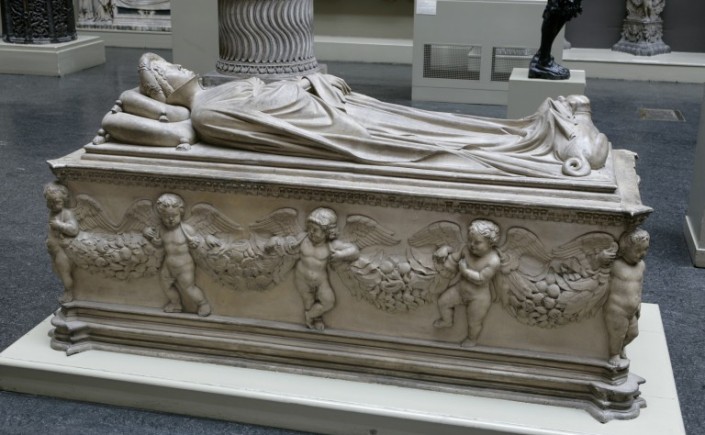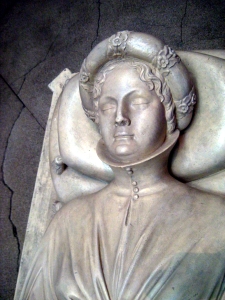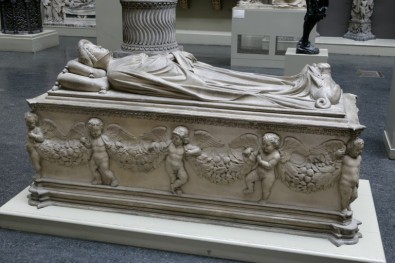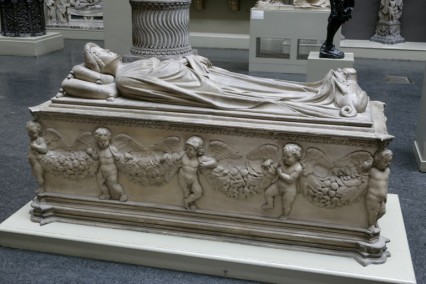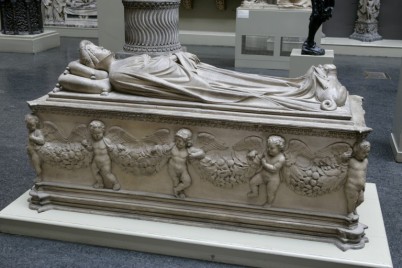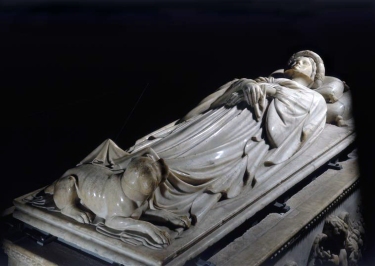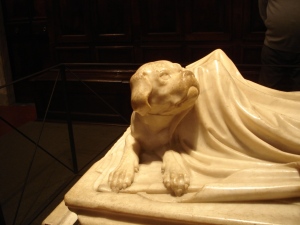Continuing on from part one of the post on Ilaria de Carretto’s tomb, this post will focus on the analysis of the effigy and inclusion of the ten putti figures on the sides of the sarcophagus.
Detail of the effigy of the tomb of Ilaria del Carretto
The physical appearance of the effigy not only explicitly commemorates Ilaria, it simultaneously makes reference to the wealth and prestige of the Guinigi. Each aspect of the effigy, from the costume she wears, her hair style, headdress and swollen abdomen demonstrate the duality of meaning ascribed not only to this element but to the monument as a whole by her husband. Once again in a similar manner to the inclusion of the dog, the representation of the deceased Ilaria was clearly influenced by Northern European sources. The effigy had no counterparts in contemporary Italian funerary monuments.[1] The high stiff collar with its large opening which frames Ilaria’s face, the long pendant sleeves, high waisted belt, the flowered headdress and the pointed shoes were considered the height of fashion during this period, especially among the elite classes in Northern Renaissance Italian courts.[2] It demonstrated to the contemporary viewer that Paolo wished for his wife to be portrayed in a costume associated with the wealthy elite classes of Northern European and Northern Italian courts. The effigy thus projected an image of the wealth and prestige of her husband to those who saw the tomb. Paolo wished to emphasise and promote his prestigious standing in order to justify his legitimacy as the self-proclaimed ruler and Lord of Lucca. He did so by dressing his deceased wife’s effigy in a costume appropriate for a Northern European princess. Thus Paolo used the monument to further his own political agenda and to reinforce his rule to his subjects in Lucca.
The effigy’s facial features have been somewhat idealised by della Quercia, a common practice by artists of this period when portraying those of the elite class. The domed forehead, high hairline and perfectly proportioned facial features enhance and highlight the beauty of the woman commemorated by this work. Beauty was a quality deemed essential for a Renaissance woman to possess. Physical beauty was seen as an indicator of the inner qualities of a person. Thus della Quercia depicted Ilaria in her death as an ideal woman who possessed the necessary feminine qualities, such as beauty evident from the effigy’s facial features, as well as her chasteness, evoked by the presence of the sculpted dog. Thus the artist and patron chose to add various subtle symbols to the tomb’s effigy which emphasised Ilaria’s virtuous nature.
Another powerful element of the tomb is the prominence given to the wedding ring worn on the right hand of the effigy. It is interesting to note that the effigy does not wear any other form of jewellery (apart from the diadem which will be discussed below). Therefore the inclusion of this wedding band on her ring finger clearly indicated her role as a wife and marked her for posterity as her husband’s property. The ring may have ensured that this symbol of marriage stood out prominently from the rest of the effigy and tomb.[3]
Detail of the ghirlanda (headdress)
The headdress (ghirlanda) which adorns the effigy adds to the aristocratic semblance of Ilaria. In fact, the headdress looks similar to a crown, once again reinforcing Paolo’s aim to enhance his family’s prestige. A bronze diadem may have also been located at one time just above the effigy’s headdress.[4] The possibility of the presence of a physical jewelled crown would have made a powerful visual statement to the tomb’s audience. To associate Ilaria with royalty was an unambiguous and bold statement about her husband’s reign as the Lord of Lucca. Decorated with flowers, the headdress can also be interpreted as having connotations to fertility and in particular Ilaria’s fecundity. The allusion to Ilaria’s reproductive capabilities is complemented by further suggestion to this attribute by the inclusion of the putti carrying garlands loaded with fruit and flowers which will be discussed below.
The final element of the effigy which must be examined is the placement of the crossed hands on top of her noticeably swollen abdomen which serves as a potent symbol within this piece. Paolo clearly wished to subtly indicate to the tomb’s audience the cause of Ilaria’s death. In fact, Ilaria’s tomb is one of a very small number of art works depicting women which includes a reference to the cause of death as childbirth. The patron achieves this link through the positioning of the hands on the stomach, drawing the viewers’ eyes to her pregnant body. The effigy promotes Ilaria’s role as a wife and mother, echoing the message of the abundant vegetation surrounding the joint coat of arms of the two families mentioned in part one of this blog post.
Detail of the ‘joyous’ putti on the side panel of the sarcophagus
The classically influenced swag-bearing putti on the two side panels of the sarcophagus continued the monument’s emphasis on Ilaria’s commemoration as the mother of the Guinigi heir. These were the earliest examples in the 15th century of large-scale putti in Renaissance art, a motif which was to become very popular.[5] The presence of these activated nude little boys can be interpreted in a number of ways. The putto became a popular figure found on domestic objects and in particular on objects associated with the event of childbirth. Jacqueline Marie Musacchio argued that the inclusion of a naked male child held a magical resonance and their presence on domestic objects during this period clearly made reference to the much-desired male child who was essential for a society dominated by the patriarchal lineage.[6] Thus one possible interpretation for the inclusion of the putti on the sarcophagus is that Paolo wanted to emphasise his wife’s fulfilment of her duties through the birth of a male heir. The monument stood to contemporaries as a powerful visual affirmation of the strength of the Guinigi bloodline through Ladislaus’ birth. The heavy garlands which they carry are laden with fruit similar to that which surrounds the coat of arms and the effigy’s headdress. In the classical period, the garlands heaving with fruit are carried by putti referring to the ‘life-supporting spirits contained in the fruits of the earth, the source of all life in nature’.[7] The putti and garlands symbolically refer therefore to Mother Nature and placed on the tomb of a woman who died in childbirth, highlighted Ilaria’s fertile nature.
Detail of the ‘solemn’ putti on the side panel of the sarcophagus
The facial expressions and movement of the bodies of the putti are of particular interest as the two sets express very different emotions which add to the work’s commemoration of Ilaria. On one side, the putti appear sad and overburdened by the heaving garland they carry. On the opposite side, the figures appear to possess a freer spirit and perform a choral dance.[8] The polarity of the emotions evoked to the audience the emotions of the patron towards the sudden death of his young wife. The grief he felt is poignantly expressed by the solemn-looking putti and the burden they carry (the garland), a further physical manifestation of their pain and suffering. This group may also represent the sadness of Ilaria’s children over the loss of their mother at a very young age. Paolo simultaneously wanted to celebrate the life of his wife and the joy she brought to his family which is captured by della Quercia through the lively dance of the putti on the opposite panel of the tomb.
Ilaria’s tomb is a truly unique monument from the period in question in terms of its style, appearance and meaning within the Italian context. Della Quercia succeeded in combining a number of innovative features with classically-inspired elements to ensure that the tomb remains a masterpiece of western sculpture to this day. The commissioning of such a lavish work by the Lord of Lucca demonstrates the high regard he had for his wife and the mother of his first two children. Accordingly, Ilaria is memorialised for posterity as a mother by means of her physical presence on the tomb in the form of the effigy as well as the tomb’s placement in a prestigious location within the city’s cathedral. Through his design and execution of the funerary monument, della Quercia imbued Ilaria with a sense of dignity and nobility in her death which augmented her posthumous elevated standing in her conjugal family. The tomb stands as a testament to the importance of motherhood in fifteenth-century Renaissance society.
[1] Allan Marquand, ‘The Tomb of Ilaria del Carretto’, American Journal of Archaeology, Vol. 19, No. 1 (Jan-Mar 1915), pp24-33, 28.
[2] M. Paoli, ‘Jacopo della Quercia E Paolo Guinigi: Nuove Osservazioni e Ipotesi Sul Monumento di Ilaria’ in Ilaria del Carretto E Il Suo Monumento- La Donna Nell’Arte, La Cultura E La Societa Del ‘400, Ed. by Stephanie Toussaint, San Marco Lithotype, Lucca, 1995, 16-17.
[3] Charles Seymour, Jacopo Della Quercia: Sculptor, Yale University Press, London, 1973, 33.
[4] Robert Munman, Sienese Renaissance Tomb Monuments, American Philosophy Society, 1993, 121.
[5] James Beck, Jacopo della Quercia, Vol. 1, Columbia University Press, New York, 56.
[6] Jacqueline Marie Musacchio, The Art and Ritual of Childbirth of Renaissance Italy, Yale University Press, New Haven, 1999, 127.
[7] Charles Dempsey, Inventing the Renaissance Putto, University of North Carolina Press, Chapel Hill and London, 2001, 28.
[8] A. Marquand, ‘The Tomb of Ilaria del Carretto’, 31.

